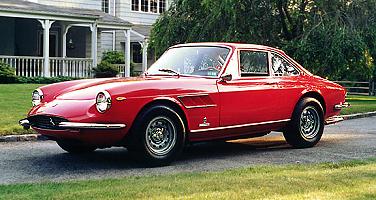 Ferrari 330
Ferrari 330
This page covers the following models :
The first road car bearing the '330' badge, the 330 America was launched in 1963. It was basically a re-engined 250 GTE 2+2 which, apart from the new 4-litre engine, featured virtually no changes, the only visible one being the '330 America' badge on the bootlid. A total of 50 cars were built.
The engine was to all appearances the same 4-litre unit as in the 400 Superamerica, retaining the same bore, stroke and capacity, but actually it had
some fundamental differences, most notably an increased bore spacing, which meant a heavily revised production line. The spark plugs were also repositioned,
an alternator replaced the dynamo and the water pump was new. The increase of power to 300bhp saw the internals of the gearbox strengthened.
The suspension retained the same basic setup as its forerunners, but gained adjustable dampers by Koni and improved disc brakes, still by Dunlop. The
latter featured independent front and rear circuits, complete with separate master cylinders, servos and fluid reservoirs.
In 1965 the four-speed with overdrive
transmission was replaced by a five-speed unit, new cast light-alloy wheels were introduced (the Borrani wire wheels became an option)
and, most significantly, a new nose design with only two headlights replaced
the previous slanted four-light setup. Numerous other minor details, such
as the addition of bumper overriders, also changed whilst air-conditioning and power-steering became available as options.
Production continued until late 1967 by which
time 1075 (500 series I and 575 series II) cars had been built. It was
replaced by the 365 GT 2+2.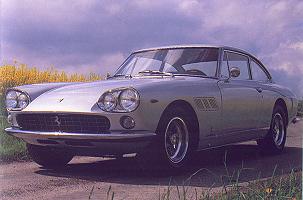 The
real replacement for the 250 GTE 2+2 was launched in January 1964. The
new car, known as the 330 GT 2+2, was still heavily based on the model
it replaced, featuring a development of the old chassis stretched by 50mm,
but was visibly different due to the new nose and tail designs, as usual
by Pininfarina. These were not well accepted by all.....
The
real replacement for the 250 GTE 2+2 was launched in January 1964. The
new car, known as the 330 GT 2+2, was still heavily based on the model
it replaced, featuring a development of the old chassis stretched by 50mm,
but was visibly different due to the new nose and tail designs, as usual
by Pininfarina. These were not well accepted by all.....
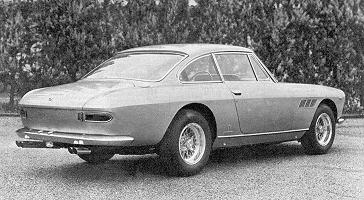 |
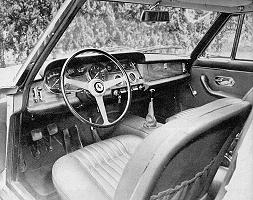 |
Technical Details
| Engine | 3967cc (77x71mm) 60deg V12 sohc (per bank) 300bhp @ 6,600rpm |
| Suspension | front : independent with double wishbones and coil springs
rear : live axle with coil springs wheelbase : 2650mm track (front/rear) : 1390mm/1380mm |
| Brakes | discs all round |
| Transmission | 4 speed manual with overdrive
later, 5 speed manual |
| Weight | 1380kg |
Performance
|
Maximum speed
Standing km Acceleration 0-100km/h Braking distance from 100km/h |
224km/h
27.65 seconds 7.2 seconds 61.5 meters |
1966 saw the release of two new 330 models,
the GTC at Geneva in March and the GTS at Paris later that year.
The 330 GTC, a two-seat coupé, was basically the short wheelbase 275 chassis combined with the 330 GT 2+2 4-litre engine. Mechanically it followed more
the 275 with its independent rear suspension, whilst the engine featured a new mounting system which significantly improved the NVH. Pininfarina designed
a new body which took many cues from other then-current Ferraris.
The 330 GTS, was simply an open-topped version of the coupé.
Around 600 examples of the coupé
and 100 examples of the spider were built before production stopped in
1968. The replacements were the 365GTC/4 and 365
GTS respectively.
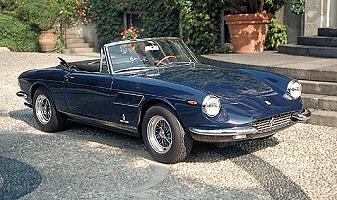 |
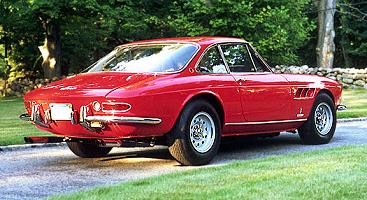 |
Technical Details
| Engine | 3967cc (77x71mm) 60deg V12 sohc (per bank) 300bhp @ 6,600rpm |
| Suspension | front : independent with double wishbones and coil springs
rear : independent with double wishbones wheelbase : 2400mm |
| Brakes | discs all round |
| Transmission | 5 speed manual |
A four-litre derivative of the 250 GTO this was easily recogniseable by the large power bulge in the bonnet. Around three cars were built.
1964 saw the first 330P emerge from Maranello. This was effectively a stretched 250P with the 4-litre engine. It was followed shortly afterwards by the 330P2, which was completely new. With a new chassis, suspension and 410bhp @ 8,200rpm it debuted with NART at Daytona in 1965. The following year saw the 330P3 arrive, with a ZF transmission and fuel injection it intorduced many novelties for a Ferrari. Following several successes Ferrari rolled out the 330P4 for the following season. With a new 3 valve cylinder-head and injection system the power went up to 450bhp whilst the transmission reverted to an in-house Ferrari unit. It was sufficient to win the World Manufacturers Championship for Ferrari - again.
There are also wallpapers/desktop backgrounds available to download.![]() See our picture gallery index for images from museums, motorshows and events.
See our picture gallery index for images from museums, motorshows and events.
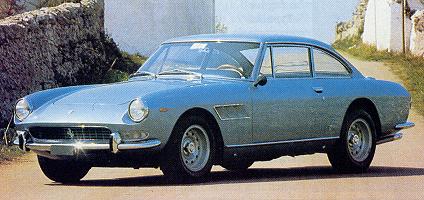
Use the buttons at the top to navigate
further, or
Copyright © 2000 to 2011 CarsfromItaly